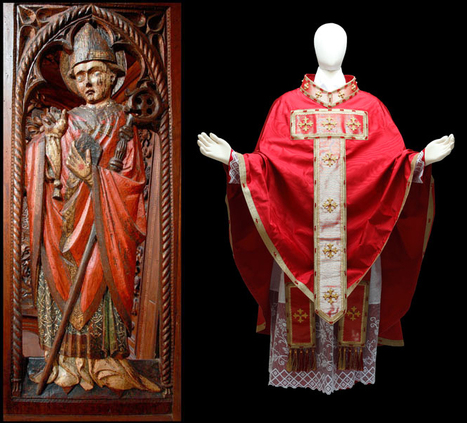A small company in Ascoli Piceno keeps in life the ancient art of Holy Paraments' creation. Precious material as gold, zircons, silver, crystal swarovski and fine silk, need a scrupulous attention and good artistic skills in working. The inspiration is always the past well represented in frescos, paintings and statues. Casula, Mitre, Surplice is how this art, ignored by the mass, finds its expression.
The casula in the picture with the respective stole and mitre were wholly inspired by the model that the iconography of the Saint Bishop Emidio presents on the wooden choir of the 15th century (It’s among the four greatest Italians choirs) situated in the central apsis of the Cathedral of Ascoli Piceno.
The cut of the paraments is typically medieval: the big stole is no more a “hidden sign” under the casula , but it is visible as the main sign of the presbyteral ministry, in fact, whereas the casula is a liturgical vestment, the stole, the mitre and the pastoral are liturgical insignias, moreover it’s one of the ancient insignia. The rich gems of the paraments underlines the regalness of Christ symbolized by the Bishop who has the fullness of the priesthood and by the Presbyter in communion with his own bishop. The gems represent also the several charisms whose / of which the saint Church is rich, all contribute to create a single body/main part.
Main features of the materials and the manufacturing:
Invisible seams Red fabric 100% watered silk N°16 crosses handmade in gold cm 7x7 N°9 crosses handmade in gold cm 3.50x3.50 N°10 tassels gold/red h.cm. 11 N° 16 red zircons of 8 mm in a silver mounting (certified) N° 9 white zircons of 8 mm in a silver mounting (certified) N°459 red bicono of 6 mm Swarovski (certified) Fine gold braid ancient furniture h.cm.3 Fine gold braid ancient furniture h.cm.1.5 Gold spinet with one bladeVia Mariano Pallottini



 Your new post is loading...
Your new post is loading...







